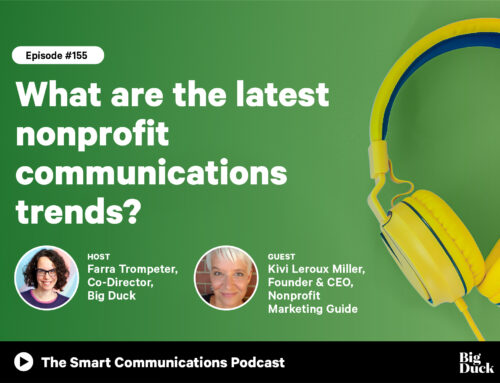
Kristan Allen
Kristan Allen and her work as the director of marketing and communications for The Mentoring Partnership of Southwestern Pennsylvania were featured in my book Content Marketing for Nonprofits. She took part in our first Book Club discussion panel a few weeks ago and had such great things to say, we asked her to share her insight with you. ~Kivi
Guest Post by Kristan Allen of The Mentoring Partnership of Southwestern Pennsylvania
We’ve all heard about “key messages” and “elevator pitches.” These phrases have become a bit overused and, in a sea of communications jargon, probably find themselves wedged somewhere between “grassroots” and “low-hanging fruit.” And while the phrases themselves may be a little tired, the true meaning behind them has never been more important.
At a time when everyone is overwhelmed by information overload, it’s becoming more and more difficult for nonprofits to share their cause and, more importantly, get people to connect with it. In this age of tweets, pins, hashtags and fast-paced, instant-gratification social media, our opportunities for communicating about our organization are oftentimes shortened to a mere few minutes of captive time before our audience is on to the next thing.
As the communications director for The Mentoring Partnership, a nonprofit that acts as an intermediary, providing resources to other nonprofits, I have the great opportunity to provide support and counsel to a variety of groups. While each of the programs I work with is wonderfully unique, many of them have shared one similar challenge: a lack of core organizational messages that makes it difficult to share compelling information with others. And they aren’t alone. I was in this same situation and, as I worked to help myself and others, I’ve found a few common themes that make crafting and keeping core messages easier.
Don’t Worry, It’s All Up Here
If you’re like many of us (yes, I’m including myself here), you’re probably pointing thoughtfully to your head and saying: “Of course we have key messages about our organization. They’re all right up here.” When I first joined TMP, I fell into this category. But I quickly began to realize that, regardless of how familiar you are with a topic, it can be hard to recall some of the more important, compelling points when you’re trying to cram as much information as you can into a 30-second conversation you’re having at a networking luncheon. Or in an elevator. Or at a social event. So before you start this process, remember one thing: after you’ve taken the time to think through your core organizational messages, write them down. They aren’t helpful to anyone (not even yourself) if they’re locked away in the depths of your brain.
What Do You Mean Target Audience? We Want to Reach Everyone!
No you don’t. As amazing as you think your organization is (and it is!), there are always going to be people who aren’t a good fit for you – maybe they just don’t have the time to support your organization right now. Perhaps they already have very strong ties to another organization. Or, brace yourself — maybe it’s possible that they just don’t have an interest in what you do. Regardless, one of the first things you need to do before you can develop your core messages is identify who you want to reach with them.
I always leaned very heavily on the phrase “target audience,” but after reading Kivi’s Content Marketing for Nonprofits book, I’ve come to embrace a new concept she introduced: knowing your PSIs– aka Participants, Supporters and Influencers. The term “PSIs” captures the more evolved nature of communications with our key constituents. Gone are the days of rapid-fire, one-way communication where we’re just talking to people and hoping some of our info sticks. Today, effective communication involves a two-way dialogue where we’re creating a community of people who are invested in a shared cause and join in the conversation around it. In identifying people we want to communicate with, it’s important to view them as active participants and make sure our core messages work not just to inform them, but also to engage them.
Keep It Simple, Sweetheart
As you develop key messages about your organization, keep it as simple as possible. No one likes an overuse of jargon or industry-specific terms. They immediately distance you from your audience and make it harder for them to connect with your work on a more personal level that will, ultimately, facilitate a stronger connection and lead to that higher level of engagement we’re all striving for. Mission statements are great, but even those are oftentimes cluttered up with a lot of information that, at the end of the day, leaves your audience with no lasting takeaways. Take your more formal, organizational hat off for a minute and think about how you would explain your work to a friend or family member over a cup of coffee. How would you explain it to a group of fourth graders at Career Day? Getting back to basics can help you zero in on messages that are concise and relatable to the full spectrum of your PSIs.
Create Your Brand Ambassadors
Now that you’ve gone through the process of identifying PSIs, crafting relevant and impactful messages and getting everything down on paper, it’s time to put this info to work for you. By putting it to work, I mean sharing it with everyone who communicates about your organization. One of the biggest benefits of having a set of core messages down on paper is that they can easily be used to equip others with concise, consistent information about your organization. The obvious starting point is internally with your colleagues, but don’t forget to branch out to external constituents. Sharing information with your board of directors, volunteers and other key supporters can help you create a network of brand ambassadors that feels confident sharing important and accurate information about your organization with others.
Investing in your core key messages can go a long way in helping you raise awareness of your organization and your cause. Happy messaging!
Kristan Allen is the Director of Marketing and Communications at The Mentoring Partnership, an intermediary nonprofit organization that provides resources and training to youth mentoring programs in Southwestern Pennsylvania. She has a passion for messaging and all the excitement and headaches that often come with it. You can reach her at kallen@mentoringpittsburgh.org. Visit The Mentoring Partnership at www.MentoringPittsburgh.org.






